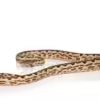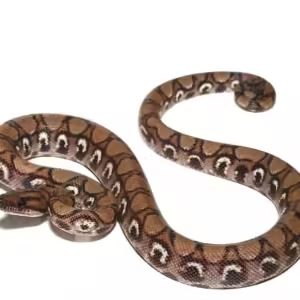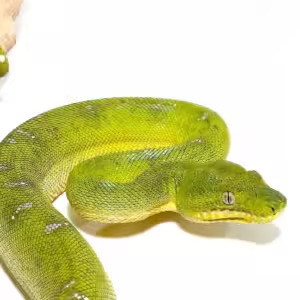Jungle Fire Het T+ Albino Boa For Sale
$799.99
WE HAVE BABY JUNGLE FIRE HET T+ ALBINO BOA FOR SALE. HERE ARE SOME HIGHLIGHTS:
- Boa Constrictor imperator
- Captive Bred
- Males
- Approximately 20 Inches In Length From Head To Tail
- This Is A Smaller Species Of Boa With Adults Growing To About 5ft
- Feeding On Live Or Frozen Thawed Hopper Mice
- Endemic To Central America In The Forests Of Belize, Costa Rica, Panama, And Nicaragua
- This Is A Smaller Species Of Boa That Only Grows To 4 – 6 Feet In Length From Head To Tail
- With Proper Care And Setup These Can Live 20 – 30 Years On Average In Captivity
- This Boa Prefers Tropical Conditions So Be Sure To Provide A Large Water Dish For Proper Humidity And Branches For Climbing
Jungle Fire Het T+ Albino Boas
The Jungle Fire Het T+ Albino Boa represents a captivating and unique morph of the common boa constrictor, known for its striking appearance and genetic distinctiveness. This particular morph is a result of selective breeding, combining the Jungle, Fire, and T+ Albino genes to produce a snake that is both visually stunning and genetically intriguing. The Jungle gene contributes to a pattern-enhanced appearance, the Fire gene offers a cleaner and brighter color palette, and the T+ Albino gene reduces melanin, giving the snake its characteristic light and vibrant look.
One of the most remarkable features of the Jungle Fire Het T+ Albino Boa is its appearance. These boas exhibit a vivid and contrasting color pattern that includes rich yellows, oranges, and whites, often with a clean and well-defined pattern. This morph’s aesthetic appeal makes it highly sought after among reptile enthusiasts and collectors. Their unique appearance is not only a testament to the power of selective breeding but also a point of fascination for those interested in reptile genetics and herpetology.
In addition to their striking appearance, Jungle Fire Het T+ Albino Boas are known for their manageable size and generally docile temperament, making them suitable for both novice and experienced snake keepers. Typically, they reach lengths of 6 to 8 feet, which is relatively modest compared to other large constrictors. Their temperament is generally calm, and with proper handling, they can become quite accustomed to human interaction.
The popularity of Jungle Fire Het T+ Albino Boas has grown significantly in recent years, driven by their unique genetic makeup and stunning visual appeal. They are a prime example of how selective breeding can enhance and preserve desirable traits within a species. For those passionate about reptile breeding and genetics, these boas offer an exciting opportunity to explore and appreciate the intricacies of herpetological science.
Genetics and Morphology
The Jungle Fire Het T+ Albino Boa represents a fascinating convergence of genetics and morphology. Understanding the genetic composition of these striking boas requires delving into the specifics of the ‘Jungle Fire’ and ‘Het T+ Albino’ genes. The Jungle gene is responsible for intricate, often chaotic patterns, creating a visually stunning effect. This gene can cause variability in pattern, making each snake unique, with a mix of bold stripes and swirls that captivate enthusiasts.
The ‘Fire’ gene, on the other hand, works to enhance coloration, often resulting in a brighter, cleaner appearance. When combined with the Jungle gene, the result is an even more vivid and dynamic pattern that sets these boas apart from others. The ‘Het T+ Albino’ designation signifies that the snake carries the recessive T+ Albino gene. While these snakes do not exhibit albinism themselves, they can produce albino offspring if paired with another ‘Het T+ Albino’ or a visual T+ Albino boa.
Breeding Jungle Fire Het T+ Albino Boas involves understanding the inheritance patterns of these genes. When two Het T+ Albino boas are bred together, there is a 25% chance of producing a T+ Albino offspring, a 50% chance of producing another Het T+ Albino, and a 25% chance of producing a normal, non-albino boa. Incorporating the Jungle and Fire genes into the equation adds layers of complexity, as these genes exhibit dominant and co-dominant inheritance patterns, respectively.
Breeders must also navigate genetic nuances and potential challenges. For instance, while aiming to produce the ideal morph, they must avoid genetic pitfalls such as inbreeding, which can lead to health issues. Additionally, understanding the visual markers of ‘het’ snakes is crucial for making informed breeding decisions. The intricate dance of genetics in these boas not only underscores the importance of knowledge and precision in breeding but also the allure and unpredictability of working with such captivating creatures.
Appearance and Physical Characteristics
The Jungle Fire Het T+ Albino Boa is a captivating snake morph, renowned for its striking and vivid appearance. One of the most notable features of this morph is its coloration. The base color typically exhibits a blend of deep, rich browns and fiery oranges, creating a mesmerizing contrast that draws immediate attention. This vibrant palette is punctuated by intricate patterns, which often include irregular splotches and bands that snake their way along the body. These patterns are usually darker than the base color, adding to their visual complexity.
A unique aspect of the Jungle Fire Het T+ Albino Boa’s coloration is the presence of a genetic trait known as “T+ Albino.” This trait results in reduced melanin, leading to lighter, more translucent shades compared to non-albino boas. The “Jungle” aspect of this morph further enhances its allure, contributing to a more chaotic and visually dynamic pattern compared to standard morphs. The combination of these traits creates a vivid tapestry that is both beautiful and unique.
In terms of size, the Jungle Fire Het T+ Albino Boa generally reaches lengths of 6 to 8 feet, depending on gender and individual growth rates. Their bodies are robust and muscular, typical of the boa species, providing them with the strength needed for their natural constricting behavior. The texture of their scales is smooth and glossy, which not only adds to their visual appeal but also makes them a tactile delight for handlers.
As these boas mature, their coloration and patterns can undergo subtle changes. Juveniles often exhibit more vibrant and pronounced colors, which may mellow slightly as they age. However, the core characteristics of their appearance, such as the distinctive pattern and overall coloration, remain prominent throughout their lifespan. The Jungle Fire Het T+ Albino Boa’s unique physical characteristics make it a standout choice for reptile enthusiasts and collectors alike, offering a blend of beauty and intrigue that is hard to match.
Habitat and Natural Environment
Boa constrictors, including the captivating Jungle Fire Het T+ Albino Boas, are native to diverse regions in Central and South America. These serpents are typically found in tropical rainforests, savannas, and semi-arid scrublands. The climate in these areas is generally warm and humid, with temperatures often ranging between 75°F to 85°F (24°C to 29°C) during the day and slightly cooler at night. High humidity levels, often between 60% to 80%, are a staple of their natural environment, providing the moisture necessary for their skin health and respiratory functions.
The terrain of their natural habitat varies greatly, from dense, lush undergrowth in rainforests to more open, arid regions with scattered vegetation. This variation in terrain influences their behavior and adaptations. In dense forests, these boas are often found near the ground, utilizing the underbrush and fallen trees for cover and hunting. In more open areas, they may be found basking on rocks or hiding in burrows to avoid the heat of the midday sun.
Understanding the natural environment of the Jungle Fire Het T+ Albino Boas is crucial for their care in captivity. Replicating the warmth and humidity of their native habitat is essential for their well-being. Enclosures should be equipped with regulated heating elements to maintain appropriate temperatures, along with humidity controls to mimic their natural conditions. Additionally, providing a varied terrain within the enclosure, including climbing structures and hiding spots, can help stimulate natural behaviors and support their physical health.
These environmental factors also play a significant role in their behavior and health. Proper temperature and humidity levels are vital for digestion, shedding, and overall metabolic functions. A habitat that closely mirrors their natural surroundings will not only enhance their physical health but also reduce stress, leading to a more content and active boa.
Captive Care Requirements
Jungle Fire Het T+ Albino Boas require meticulous care to thrive in captivity. The first consideration is the enclosure size. Juvenile boas can be housed in a 10-20 gallon tank, but as they grow, adults will need a larger space, ideally a 4x2x2 feet enclosure to move around comfortably. The enclosure should be secure to prevent escapes, with a tightly fitting lid and locks if necessary.
Temperature regulation is crucial for these boas. The enclosure should have a thermal gradient, with a basking spot maintained between 88-92°F and a cooler side around 78-80°F. This can be achieved using under-tank heaters, ceramic heat emitters, or heat lamps. It’s important to use thermostats to prevent overheating. Nighttime temperatures can drop to 75-80°F, mimicking their natural environment.
Humidity levels should be kept between 50-60%, with occasional spikes up to 70% during shedding periods. This can be managed by misting the enclosure regularly and providing a large water bowl for humidity and hydration. Substrates like cypress mulch, coconut husk, or aspen shavings are preferred as they retain moisture well and are easy to clean.
Hiding spots are essential for Jungle Fire Het T+ Albino Boas to feel secure. Provide at least two hides, one on the warm side and one on the cool side of the enclosure. These hides should be snug enough to give the boa a sense of security but large enough to accommodate their body.
Diet for these boas mainly consists of appropriately sized rodents. Feed juveniles every 5-7 days and adults every 10-14 days. Prey size should be proportional to the girth of the snake, usually no larger than the widest part of their body. Monitor feeding habits and adjust the schedule as needed to maintain healthy body condition.
Shedding is a natural process for Jungle Fire Het T+ Albino Boas, and proper humidity levels are essential for a complete shed. Ensure the enclosure is adequately humidified, and provide a shedding box with damp sphagnum moss if necessary. Common health issues to watch for include respiratory infections, mites, and scale rot, often caused by improper humidity and temperature levels.
Maintaining optimal living conditions involves regular cleaning of the enclosure, providing fresh water daily, and monitoring temperature and humidity levels consistently. By adhering to these care requirements, you can ensure the well-being and longevity of your Jungle Fire Het T+ Albino Boa in captivity.
Behavior and Temperament
Jungle Fire Het T+ Albino Boas are known for their distinct and captivating behavior, making them a popular choice among reptile enthusiasts. Generally, these boas exhibit moderate activity levels, often seen exploring their enclosures during twilight hours. They are primarily nocturnal, which means they are more active during the night but can occasionally be active during the day.
When it comes to handling, Jungle Fire Het T+ Albino Boas can be quite docile if properly socialized from a young age. Regular, gentle handling is key to developing a trusting relationship with these snakes. It’s important for handlers to approach them calmly and confidently to avoid startling the boa, as sudden movements can trigger defensive behaviors.
Interactions with humans can vary depending on the individual snake’s personality. While many Jungle Fire Het T+ Albino Boas are known for their calm and tolerant nature, it’s crucial to recognize that each snake has its own unique temperament. Some may be more reserved or shy, requiring additional time and patience to acclimate to handling and human presence.
One common misconception about Jungle Fire Het T+ Albino Boas is that they are aggressive or prone to biting. In reality, these behaviors are typically a result of stress, improper handling, or an unfamiliar environment. To mitigate these concerns, it is essential to create a stable, secure habitat and to handle the snake regularly but not excessively.
Building trust with a Jungle Fire Het T+ Albino Boa involves consistent and positive interaction. Owners should allow the snake to explore their hands and surroundings at its own pace, ensuring a stress-free experience. Over time, the boa will become more accustomed to handling, reducing any initial apprehension.
Understanding the behavior and temperament of Jungle Fire Het T+ Albino Boas is integral to successful ownership. By recognizing individual personalities and providing appropriate care and interaction, owners can foster a harmonious and rewarding relationship with these fascinating reptiles.
Breeding and Reproduction
The breeding process for Jungle Fire Het T+ Albino Boas involves a series of carefully timed and monitored stages to ensure the health and viability of both the parents and offspring. Breeders typically initiate the breeding season during the cooler months, usually from November to January, to mimic the natural environmental changes these boas would experience in the wild. This period encourages mating behaviors, which include increased activity, courtship, and copulation.
Mating behaviors in Jungle Fire Het T+ Albino Boas are characterized by the male’s active pursuit of the female, often involving physical contact and intertwining. Successful copulation may occur multiple times over several days to ensure fertilization. After mating, it is crucial to provide optimal conditions for gravid females, including a temperature gradient within the enclosure, adequate hydration, and a nutritionally rich diet to support the developing embryos.
The incubation period for Jungle Fire Het T+ Albino Boas is around 100 to 120 days, during which the female retains the eggs internally, giving birth to live young rather than laying eggs. As the due date approaches, breeders should closely monitor gravid females for signs of labor, such as restlessness and increased basking behavior. Providing a secure and comfortable birthing environment is essential to alleviate stress during this critical period.
Once the young boas are born, they require specific care to thrive. Neonates should be housed individually to prevent stress and competition. Their enclosures should maintain appropriate temperature and humidity levels, with ample hiding spots to mimic their natural habitat. Initial feedings should consist of appropriately sized prey items, offered two to three days after their first shed, which typically occurs within a week of birth.
Genetically, Jungle Fire Het T+ Albino Boas are a fascinating subject, as breeders aim to produce offspring with desirable traits by understanding and manipulating genetic inheritance. Special considerations include ensuring genetic diversity and avoiding inbreeding, which can lead to health complications and reduced vitality. Careful selection of breeding pairs based on genetic compatibility and health history is paramount to producing robust and healthy young boas.
Ethical Considerations and Conservation
The realm of breeding and owning Jungle Fire Het T+ Albino Boas brings to the forefront several ethical considerations that must not be overlooked. Responsible breeding practices are paramount in maintaining the health and genetic diversity of these exotic creatures. Breeders should prioritize ethical standards, focusing on the well-being of the boas rather than purely on profit. This involves avoiding overbreeding, which can lead to genetic bottlenecks and health issues within the population. Ensuring a diverse gene pool is critical to the long-term viability of these captivating reptiles.
Conservation efforts for wild populations of boa constrictors are equally significant. Habitat destruction and illegal trade have severely impacted wild boas, making conservation initiatives essential. Captive breeding programs play a crucial role in supporting these efforts by providing a sustainable alternative to wild-caught specimens. These programs can help alleviate the pressure on wild populations, ensuring that their numbers remain stable and that genetic diversity is preserved.
For potential owners, the decision to keep a Jungle Fire Het T+ Albino Boa should not be taken lightly. These exotic pets require a long-term commitment, with lifespans that can extend over several decades. Prospective owners must be prepared to provide appropriate care, including proper housing, diet, and medical attention. The impact of keeping such a pet extends beyond the individual animal; it also influences broader conservation efforts and the overall perception of exotic pet ownership.
By considering these ethical and conservation aspects, breeders and owners alike can contribute positively to the world of Jungle Fire Het T+ Albino Boas. Responsible practices ensure the health and longevity of these remarkable reptiles while supporting the preservation of their wild counterparts. Through informed and conscientious decisions, we can enjoy the beauty and uniqueness of these boas while promoting their welfare and conservation.





















Reviews
There are no reviews yet.